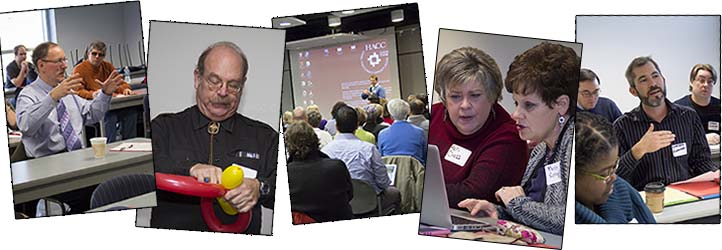
Two hundred faculty members, both full time and adjunct, came together on January 9, 2014 to discuss General Education. Faculty members met in focus groups and considered the findings of the General Education assessment initiatives that had been conducted throughout 2013. In their breakout groups they talked about the ways in which the General Education Outcomes were addressed in their courses; and they talked about ways in which they could respond to the assessment findings. Click here to view our e-newsletter. (pdf)
HACC's General Education Outcomes may be viewed here.
The General Education Outcome assessment process takes snapshots of student performance related to each of these competencies so that faculty members, disciplines, and programs can make better-informed decisions about how best to conduct their classroom instruction and support student learning. Discussion highlights follow.
Information Literacy |
Oral Communication |
Written Communication |
Technology Literacy |
Critical Thinking |
Quantitative Literacy |
(Individuals who are interested in seeing the full details related to the assessment findings may contact Erin Donovan in the Institutional Research office, at emdonova@hacc.edu.)
Information Literacy [Rubric (pdf)]
Writing samples from 179 students enrolled in ENG102 were assessed, with 79% of the students demonstrating at least some proficiency across information literacy competencies. Of particular concern related to this outcome was the weakness related to the students' abilities to evaluate information; in 29% of the writing samples, students chose sources with little or no consideration to quality or the research need and they used only popular (or no) sources. In the breakout discussion, faculty members from many disciplines were discussing ways in which they could better support students in evaluating information more proficiently.
Click here to see selected faculty responses to these assessment findings. (pdf)
Oral Communication [Rubric (pdf)]
This General Education Outcome was assessed in two ways. More than 60 recorded speeches were assessed by CWAC jurors, and faculty members assessed more than 100 speeches in their own classes (7 different classes were sampled). The same rubric was applied. While the classroom faculty members tended to score somewhat higher, students in both groups showed strengths in focus, organization, style, and language delivery. Students in both groups showed weakness in physical behaviors - delivering weak eye contact, few or ineffective gestures, and demonstrating a dependence upon notes. Faculty members in the breakout session discussed ways in which they could better support their students in displaying appropriate behaviors associated with oral communication, with a chorus of ideas to provide additional formal and informal, graded and ungraded, opportunities for students to speak with one another and to get feedback regarding their effectiveness in so doing.
Click here to see selected faculty responses to these assessment findings. (pdf)
Written Communication [Rubric (pdf)]
Conducted during the spring 2013 semester, this assessment considered 113 writing samples from students enrolled in ENGL 101, SOCI201, PSYC 101, and HUM 201. More than 97% of the samples showed students having at least some proficiency across the identified competencies, with nearly 70% scoring as "proficient" or having "advanced proficiency. "While HACC is pleased to celebrate this strong student performance, it was noted that 4.5% of students did not show proficiency with writing a thesis statement (the weakest performance area).
Click here to see selected faculty responses to these assessment findings. (pdf)
Technology Literacy
In assessing this outcome, student artifacts were sampled from CIS105 since the course is required by so many programs. Rather than applying a rubric, the assessment utilized reports generated by software used by students (My ITLab). Approximately 80% of the students passed the exams on Word and Excel, and 85% passed the test on Access. While these pass rates were strong, there is some concern about the diminishing student participation rates. Faculty members attending this breakout session addressed the ways in which other courses/disciplines addressed this outcome, noting that it is sufficiently broad to be able to include a number of different technologies used in varying ways in different disciplines.
Click here to see selected faculty responses to these assessment findings. (pdf)
Critical Thinking [Rubric (pdf)]
CWAC jurors assessed 207 artifacts from nine courses:ARCH 101, CHEM 101, CJ 104, COMM 110, EXSC 102, HUM 201, MA 140, MATH 202, PHIL 101, and SOCI 202. Students performed very well in critical thinking, with 75% scoring as having "proficiency" or "advanced proficiency," and with 95% scoring as having at least "some proficiency. "One notable weak point was that of not having considered alternate points of view, with nearly 13% of students scoring as having "no/limited proficiency. This session saw a vigorous discussion about whether or not critical thinking could be judged as well from a multiple-choice question as from a written assignment. While there was no immediate answer for this, it stimulated some thoughtful exchange.
Click here to see selected faculty responses to these assessment findings. (pdf)
Quantitative Literacy [Rubric (pdf)]
This assessment used 176 samples of student work on final exams in MATH 103 and MATH 121. Students scored highest in their abilities to identify and explain quantitative information, with 57% of the students having "proficiency" or "advanced proficiency" in that competency. However, there were some concerns with both the assessment itself and the student performance related to this outcome. Because one question on the final exam was used for the analysis, the findings were thrown off when students elected not to answer that question. Faculty discussed ways of improving the assessment itself when this outcome is reassessed this spring semester.
Click here to see selected faculty responses to these assessment findings. (pdf)
